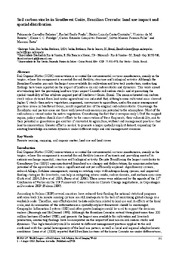Soil carbon stocks in Southwest Goiás, Brazilian cerrado: land use impact and spatial distribution.
Soil carbon stocks in Southwest Goiás, Brazilian cerrado: land use impact and spatial distribution.
Author(s): BALIEIRO, F. de C.; PRADO, R. B.; COUTINHO, H. L. da C.; BENITES, V. de M.; FIDALGO, E. C. C.; FERREIRA, C. E G.; FERREIRA FILHO, S. M.; BETTA, M.
Summary: Soil Organic Matter (SOM) conservation is essential for environmental services maintenance, mainly in the tropics, where this component is essential for soil fertility, structure and biological activity. Although the Brazilian Cerrados presents the largest area available for cultivation and livestock production, contrasting findings have been reported on the impact of land use on soil carbon stocks and dynamics. This work aimed at evaluating how the prevailing land use types impact Cerrado soil carbon stocks and at presenting the spatial variability of this attribute in great part of Southwest Goiás, Brazil. The mean estimated soil carbon stock values obtained from land under agricultural use indicated that, although some cultivated areas showed higher C stocks than native vegetation, in general, conversion to agriculture, under the major management practices in use in Southwest Goiás, result in partial loss of the original soil carbon stocks. On average the Eucalyptus and pasture areas are those with lowest carbon emission potential to the atmosphere. Most of the soil carbon is stored under the native vegetation. Considering the fact that it occupies only 1/3 of the mapped region, policy makers should direct efforts to the conservation of these fragments, their vulnerability, and to their potential as greenhouse gas emitters if converted to agriculture, without soil management practices that lead to conservation. Greater effort is needed to generate a larger spatially explicit dataset, expanding the existing knowledge on carbon dynamics under different crops and soil management scenarios.
Publication year: 2010
Types of publication: Paper in annals and proceedings
Unit: Embrapa Soils
Keywords: Land use and land cover, Mapping, remote sensing, soil organic matter
Observation
Some of Embrapa's publications are published as ePub files. To read them, use or download one of the following free software options to your computer or mobile device. Android: Google Play Books; IOS: iBooks; Windows and Linux: Calibre.
Access other publications
Access the Agricultural Research Database (BDPA) to consult Embrapa's full library collection and records.
Visit Embrapa Bookstore to purchase books and other publications sold by Embrapa.

